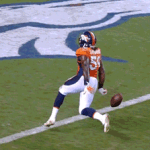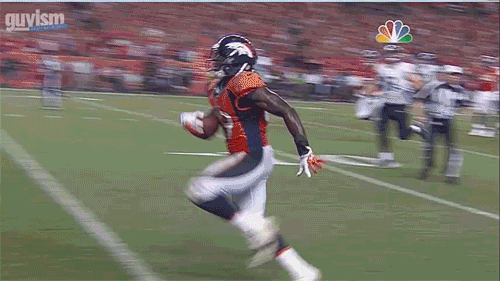
Thursday night, we saw the type of error that happens every few years in the NFL… a player, Danny Trevathan, of the Denver Broncos, was about to score an easy touchdown, yet he dropped the ball, celebrating early, before crossing “the plane” of the end zone.
It might seem like a silly rule, but a rule is a rule, so the play was ruled a touchback — zero points for the Broncos, and the ball went back to the Ravens. It didn't cost the Broncos the game, but it's worth looking at a little more closely.
Here is an animated GIF of the mishap, where he drops the ball at about the 1-yard line) or see the video here.

The NFL rules say you have to carry the ball across the end zone line. Once you cross the plane, you can drop it, spike it, “dunk” it over the goalposts, hand it to a ref, or throw it into the stands (although that draws a fine).
Being a linebacker, Trevathan probably hasn't scored too many touchdowns in his life. So, arguably, he doesn't have much practice.
That said, he's probably well aware of the rule and just had a brain cramp. He knows you have the carry the ball across and just messed up in the moment.
Tevathan said:
“It was a young mistake. I was just in the moment,” Trevathan told reporters after the game, per the Broncos‘ official website. “I thought I was in the end zone. Next time I'm going (to) hold the ball up high and give it to a fan or something. But it's not going to happen again. I'm growing from it and I'm not … going to let anybody stop me.”
Of course he thought he was in the end zone. I guess he's learned a lesson that the safest thing is to BE SURE that he's in the end zone. Barry Sanders, an NFL great running back, just flipped or handed the ball to the official instead of showboating or celebrating too much.
Friday night, my wife and I were going to have sushi delivered from a local restaurant. It was the first time I had used the restaurant's website and the interface was a bit clunky. I managed to place the order as “pick up” instead of “delivery,” as I had intended.
Now, this was totally my fault, as I should have looked closely at the confirmation email that arrived. It was only when I thought the delivery was late that I re-opened the email and realized I had screwed up.
As with many mistakes (like booking a flight for the wrong date), it's the type of mistake you tend to make just once. But, you're not the only one who has ever made that mistake (nor is Danny Trevathan – the Eagles' DeSean Jackson did it a few years ago).
I guess if Trevathan was a marginal player and that mistake had cost the Broncos the game, the worst that might have happened was him being cut by the team.
We see many situations in hospitals where people make a mistake or a slip up… and we often see situations where:
- People know the rules (or the process or the standardized work)
- They don't mean to make a mistake, but sometimes a mistake is made in the heat of the moment
When mistakes happen in hospitals (like cutting into the wrong side of a patient), we don't have video to analyze over and over. There are also generally procedures and protocols in hospital operating rooms that are meant to prevent these slip ups (but the checklists and “universal protocols” are sometimes not followed).
The Broncos wouldn't solve this problem by hanging big warning signs that say “DON'T FORGET TO CARRY THE BALL TO THE BACK LINE OF THE END ZONE” or such. They will probably address this in team meetings to make sure every player is more aware of the rules.
I'd also predict that EVERY NFL TEAM talked about this in team meetings on Friday.
When a mistake or slip up happens in a hospital, does every other hospital review the mistake so they can avoid making the same error themselves?
If Cedars-Sinai had been proactive and better managed their processes, they could have avoided repeating the same Heparin/Hep-lock mistake that a hospital in Indianapolis had made previously.
Does your healthcare team talk about things that COULD go wrong? Do you talk about errors and mishaps from other hospitals that are in the news? Do you proactively talk about how you can prevent these same errors or do you assume your people will always carry the ball the whole way into the end zone?
What do you think? Please scroll down (or click) to post a comment. Or please share the post with your thoughts on LinkedIn – and follow me or connect with me there.
Did you like this post? Make sure you don't miss a post or podcast — Subscribe to get notified about posts via email daily or weekly.
Check out my latest book, The Mistakes That Make Us: Cultivating a Culture of Learning and Innovation:










And the officials in yesterday’s Packers/49ers game didn’t follow standardized work either.
Hello,
Being an ex-professional pilot myself, I am always surprised to notice how much aviation can be an example to other branches:
1. Nobody would trust a pilot to start, taxi, Take Off and eventually land without using his/her checklist (even if he/she flies the same aircraft for 20 years). Then why not use them in other environments?
2. In aviation, there are reporting systems (see http://asrs.arc.nasa.gov/ and CASREP for Canada) where pilots can, in all confidentiality, report mishaps, near misses etc. for the sole purpose of helping others to avoid making the same “mistake”. Maybe an idea for healthcare (or others)?
Greetz,
Luc
Luc –
There are many in healthcare who have proposed a similar mandatory, non-punitive reporting system for healthcare, including my Lean author friend Naida Grunden (her husband was a commercial pilot).
http://tlcprojects.org/NEAT/ReportingErrors.html
There are some organizations doing this at a local level… but I agree that it would be more powerful at a national level.
I’m not sure (off the top of my head) what other countries are doing on this front.
Mark
Mark,
Thanks for your comment.
I think, what it really comes down to is “Culture”:
as long as people hold on to a blame culture (WHO is right/wrong iso WHAT is right/wrong) there will be a problem to establish a real non-punitive reporting system on a(n) (inter)national level. Pitty!
Luc
Spot on Mark.
Hearing about your online food ordering experience in this forum (my equivalent of a morning huddle) is exactly why I’m going to be more cognizant of delivery vs carryout options FOREVER. It is unlikely that anyone who reads this blog will ever make that mistake on any website going forward, no matter how clunky the interface or whether it is their first time ordering sushi, pizza, wings, sandwiches, etc. online. Likewise, good verbal reinforcement and disciplined coaching should limit repeat occurrence of pre-endzone celebration by any NFL, NCAA or high school players this season.
Many of us in healthcare receive daily news from the Advisory Board or other sources that provide numerous examples we can learn from. In most cases, front line clinicians are too busy taking care of patients and documenting their work to also read healthcare news articles or even internal emails about various topics. The daily huddle at gemba is exactly the conduit through which we can rapidly apply wisdom from undesired outcomes experienced by others.
tw
Good point on people not having (or not taking) the time to review lessons learned from various healthcare sources.
One thing big manufacturing companies do well is to FORCE the issue of people at different sites around the world all reviewing and learning from a safety incident that occurred at one site.
Granted, our health system is not a perfect parallel to a large global corporation for a number of reasons… but it speaks to the priority and attention placed on safety and preventing the same mistake from occurring in each hospital before each hospital learns to avoid repeating the mistake.
I’m CERTAIN that a Lean Blog reader, even after reading this post, will make this same mistake sometime. Like Steve Montague says below, I’m probably NOT the only customer to make the same mistake on this sushi place’s webpage. Actually, they use an online ordering engine from a 3rd party company. So, in theory, sushi place A should benefit from mistakes made by the customers of Thai place B… if the developer of the ordering system learns from customer mistakes or if the sushi place can do anything other than throw up their hands and say “well, that happens sometimes…”
Trevathan got it right when, rather than saying, “I’ll be more careful next time,” he said exactly what he’s going to do (“hold the ball up high”) to prevent the mistake. This is a specific, positive action that can be visualized.
As to the carry-out vs. delivery issue, I think this is much more like your post on the American Airlines reservations page. I doubt that you are the only one who made that mistake Mark, and confirmation e-mails are rarely read critically. Rather, we see them and say, “good, they got my order.”
I think a more robust solution, rather than blaming the customer (or patient), is to have the confirmation page say something like, “Your order will be ready for pick up at 7:15 p.m., please tell us what time we should expect you to be here to pick it up” with a block for the time that must be filled in to accept the order. Or, perhaps the confirmation button is actually a link to Google maps that you can use to figure out how long it will take you to get there. Bottom line is that it should be graphic, and easy to understand. There’s no such thing as error-proofing, but you can make it error-resistant.
GREAT point, Steve. Having a more specific countermeasure like holding the ball differently seems like a more effective approach than “being more cognizant.”
I’m cognizant of the risk about booking a flight on the wrong day, although I’ve been good about not repeating that error since the one time a few years ago. That said, there’s risk of me repeating the error again if I’m in a rush or if I’m tired.
I saw an article today about a surgical error and a contributing factor was the surgeon supposedly having difficult personal issues he was dealing with at the time.
I really like your suggestion about trying to confirm delivery vs pickup at the very end.
Same thing happened last night in the Oregon / Utah game, but Oregon returned it for a touchdown!
VIDEO CLIP VIA ESPN
“Travis Wilson pass complete to Kaelin Clay for 78 yds for a TD Kaelin Clay fumbled, recovered by Oregn Erick Dargan for a TD Erick Dargan fumbled, recovered by Oregn Joe Walker , return for 100 yds”
Unlike the Broncos’ player, “It’s not like Clay hasn’t scored touchdowns” (he has four this year) per the announcer.
This same thing happened again last night, a Clemson player returning a punt for what would have been a touchdown.
Video via Deadspin.com
Such a preventable error…
This might be the most comprehensive guide to this problem:
“So You Dropped the Ball Before You Scored a Touchdown”
26 occurrences documented there.
It happened again — this time in college football.
This video is a compilation of various times this has happened:
https://www.youtube.com/watch?v=EJSN4FgvoNg&ab_channel=DingProductions
This keeps happening:
It happened again in the NFL — or at least the New York Jets